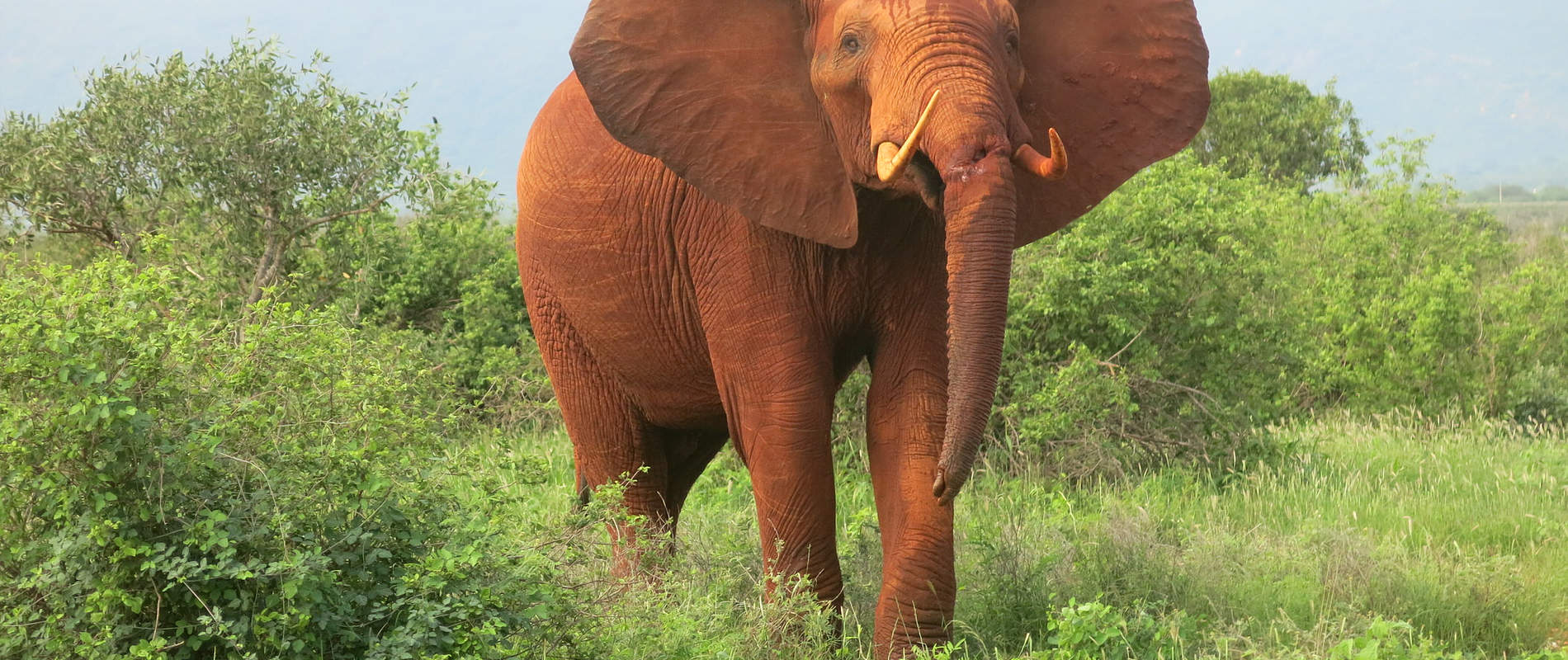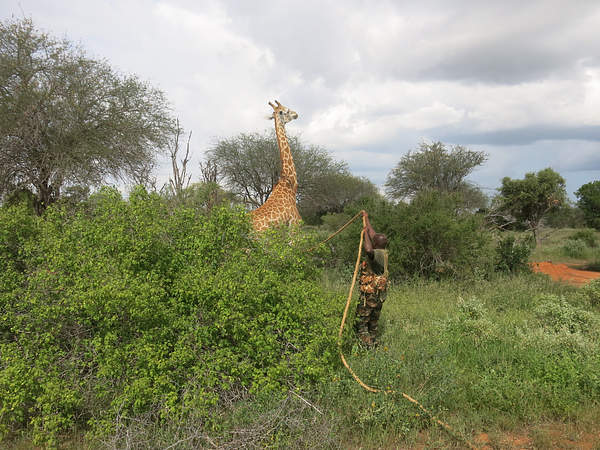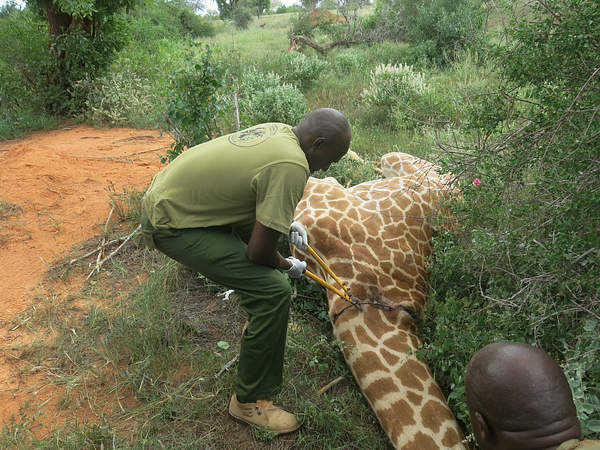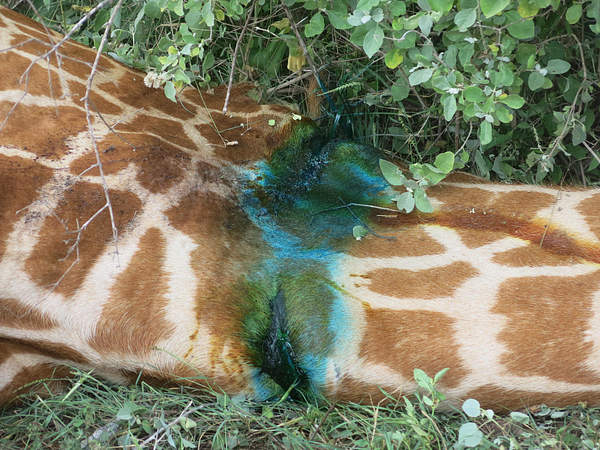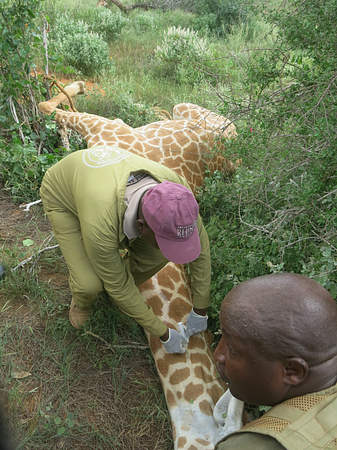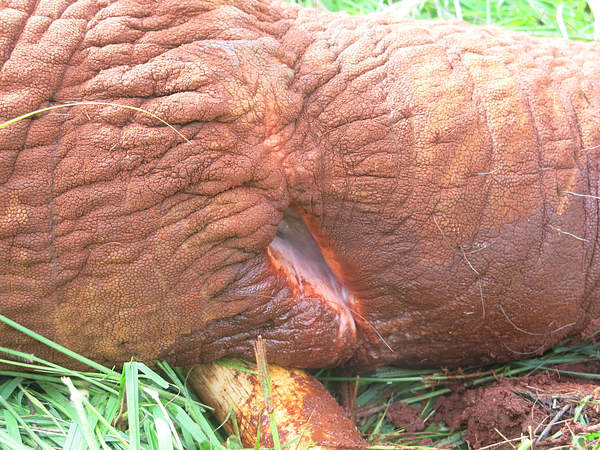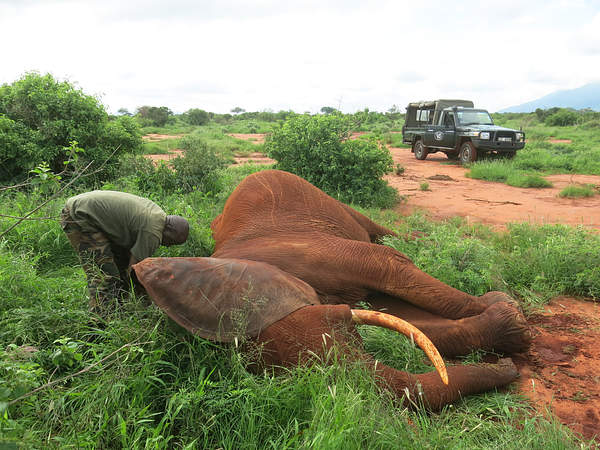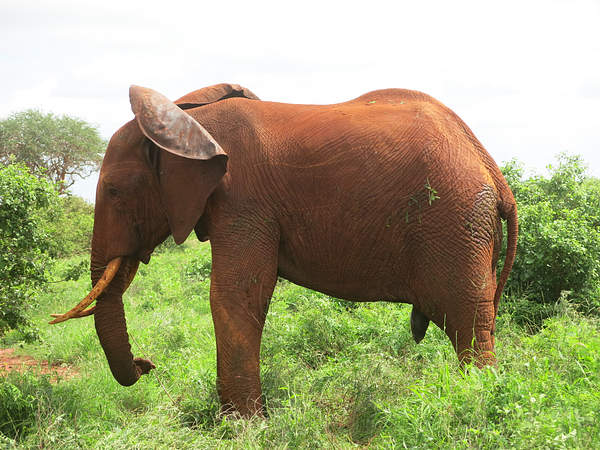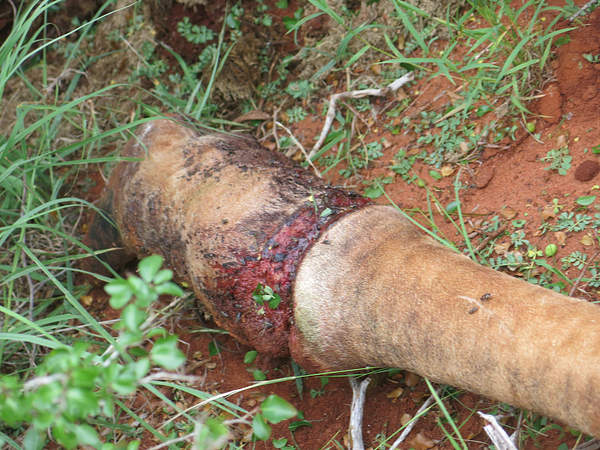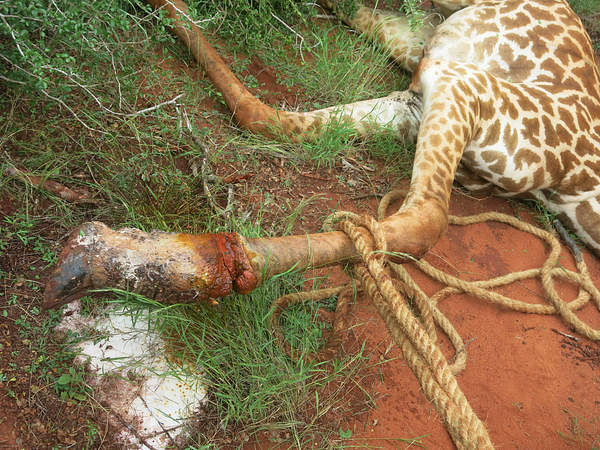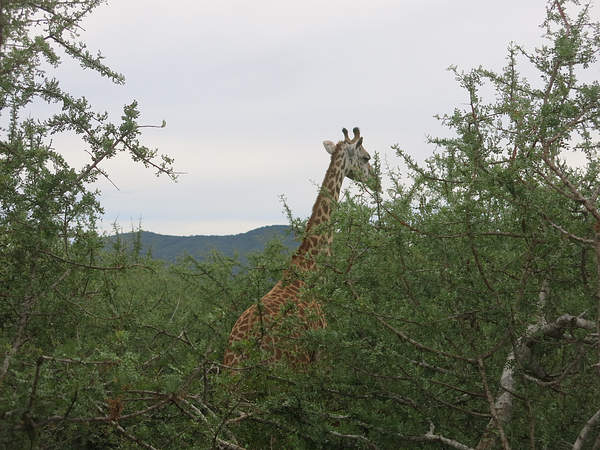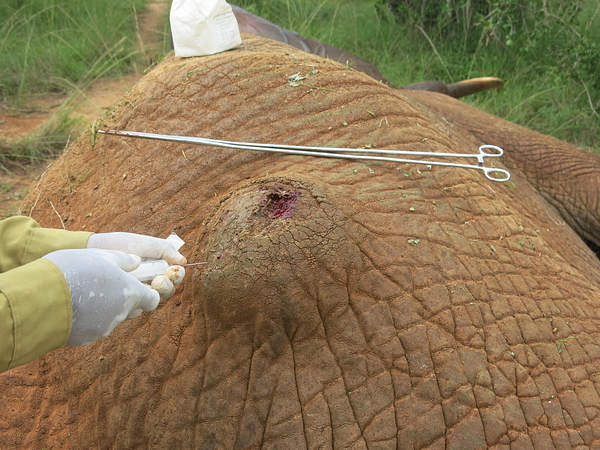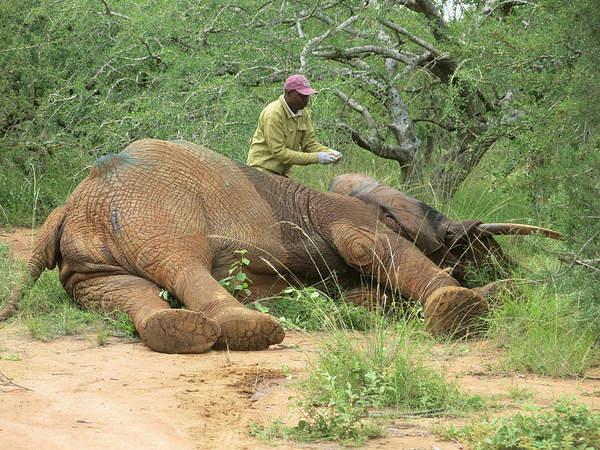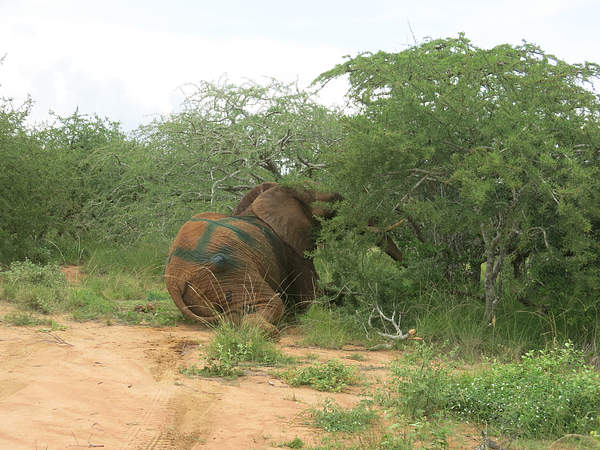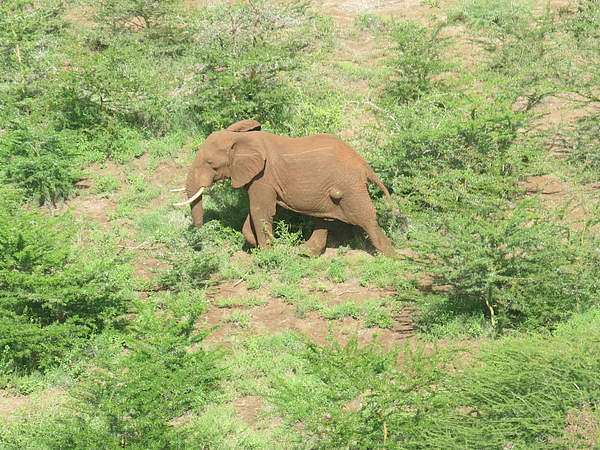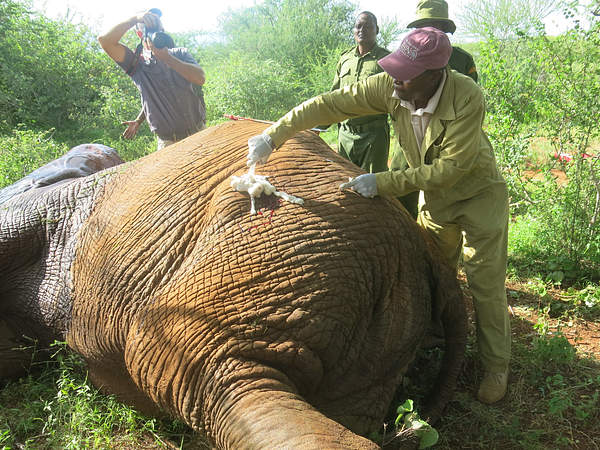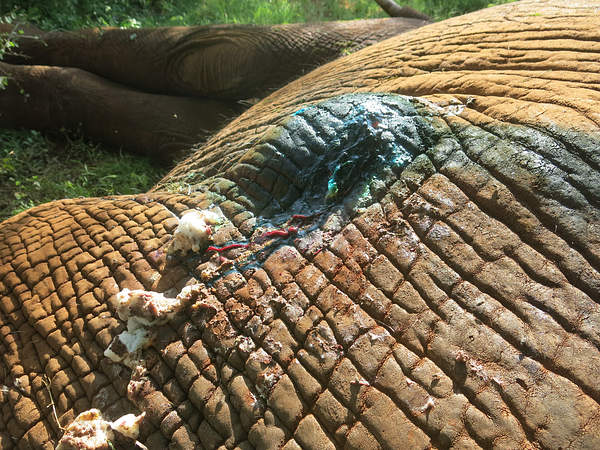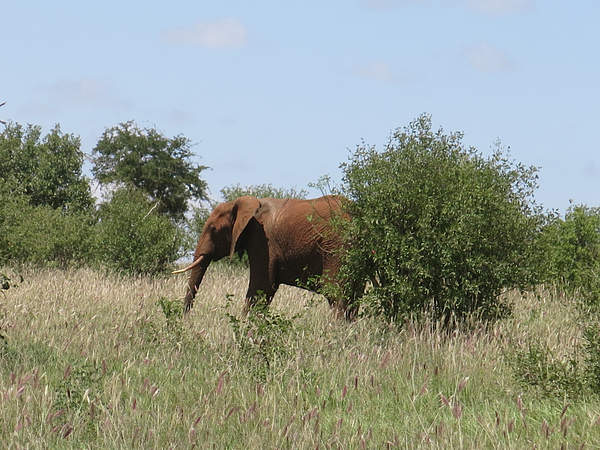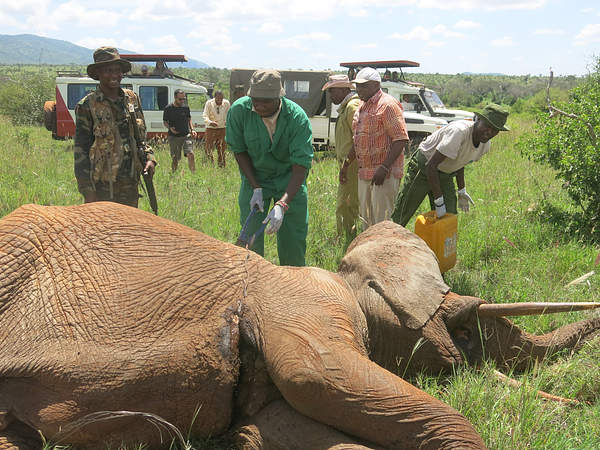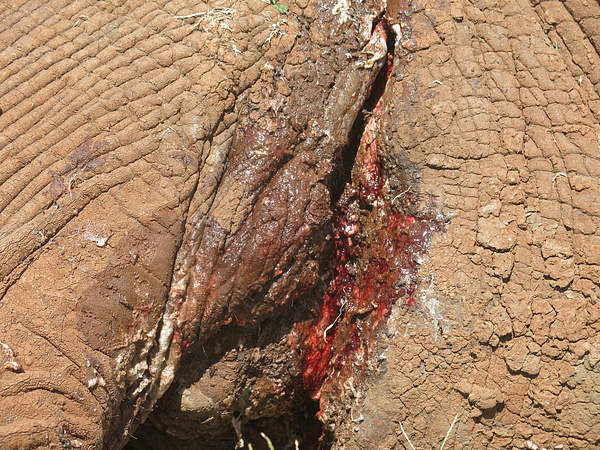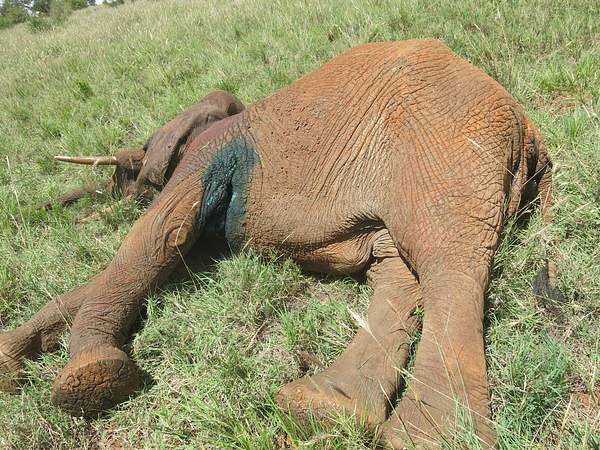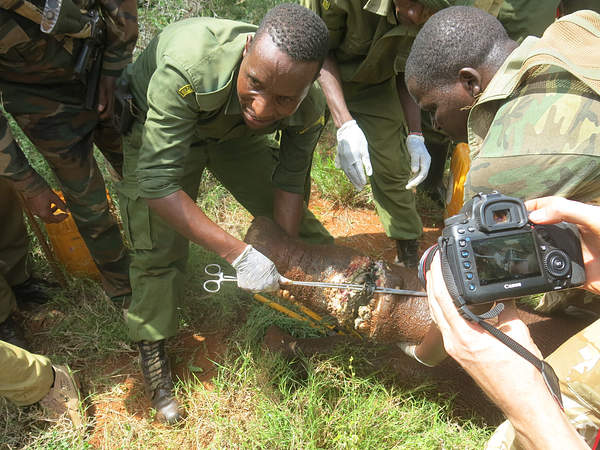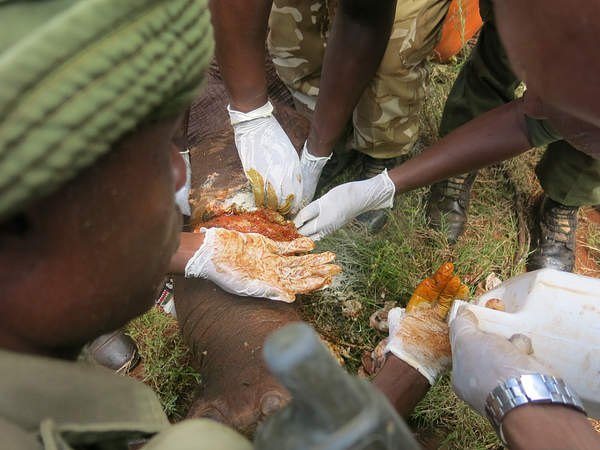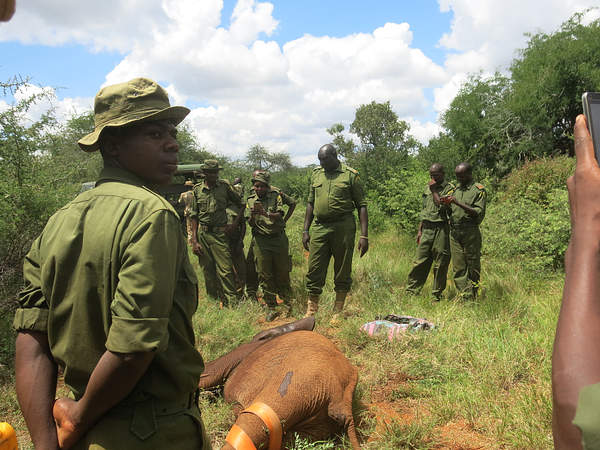Amboseli Mobile Veterinary Unit (AMVU) attended to 13 clinical cases during December 2018. Wild animals treated included elephants, a zebra, a rhino and giraffes.
Summary
All animals were treated for wounds apart from some security dogs which were vaccinated and treated with anti-trypanosome to cover for trypanosomiasis. The elephants were treated for several manner of injuries including snares and spear wounds. An additional elephant was examined for cause death but, that could not be determined due to missing parts and carrion deterioration as a result of decomposition.
CASE#1: TREATMENT OF A SNARED GIRAFFE
Date: 8 December 2018.
Species: Giraffe (Giraffa tippelskirchi)
Age: Adult
Sex: Male
Location: Lare hills (Emsaya), in Galana Kulalu
History
KWS and Galana Kulalu rangers stationed at Emsaya camp reported the snared giraffe to AMVU on 8 December.
Immobilization, examination and treatment
The giraffe was located and darted from a vehicle using 12mg Etorphine and 40mg Azaperone. While drowsy, the giraffe was pulled down manually using ropes. It went down in about 10 minutes and was placed on lateral recumbency for ease of manoeuvres and treatment.
The giraffe had a cable snare wire around the neck which had caused a wound. The wire was removed with a wire cutter. It was treated systemically with 60ml of Amoxicillin (Betamox LA®) administered through the intramuscular route. 10ml Cortisone was used for treatment to ease the pain. Hydrogen peroxide was used to debride the old wound tissue and iodine was irrigated into the wound to prevent secondary infections.
Reversal and prognosis
Intravenous injection with Diprenorphine revived the animal. The prognosis was good as there was no complications.

CASE#2: TREATMENT OF AN ELEPHANT WITH AN INJURED TRUNK
Date: 9 December 2018.
Species: Elephant (Loxodonta africana)
Age: Adult
Sex: Male
Location: Ngutuni Lodge
History
The management of Ngutuni lodge reported to Trevor Jennings at DSWT of an elephant with an almost cut trunk due to a snare on 8th. Trevor informed the AMVU of the injured elephant on the same day.
Immobilization, examination and treatment
KWS and DWST Rangers assisted in locating the elephant for treatment. The elephant was then darted from a vehicle with 20mg Etorphine Hcl. It went down in about 5 minutes and was placed on lateral recumbency for ease of treatment. The elephant trunk had a patent hole due to an old snare wound. It was not infected, and the elephant suffered no harm from it. The elephant was treated systemically with 100ml of Amoxicillin (Betamox LA®) administered through intramuscular route.
Reversal and prognosis
Intravenous injection with Diprenorphine revived the animal. The prognosis was good as the injury had no infection.
CASE#3: TREATMENT &VACCINATION OF DOGS
Date: 9 December 2018
Species: Domestic dogs (Canis lupus familiaris)
Age: Adult
Sex: Male
Location: Kaluku
History
DWST reported due dates for vaccinations of tracker/ security dogs to the AMVU.
Examination and treatment
Four dogs at Kaluku, Tsavo East National Park namely, Tanya, Max, Naiko and Parker were vaccinated against Rabies and DHLP (Distemper, hepatitis, leptospira and parvovirus). The dogs additionally, received an anti-trypanosome dose (Samorin). One dog (Naiko) was treated for otitis; wax was cleaned using swabs wetted in surgical spirit, and a vial of Gentamycin ear drop was given for daily administration via the ear canal.
CASE#4: TREATMENT OF A SNARED GIRAFFE
Date: 11 December 2018.
Species: Giraffe (Giraffa tippelskirchi)
Age: Sub-adult
Sex: Female
Location: Rukinga ranch
History
Wildlife Works reported the snared Giraffe to AMVU on 11 December.
Immobilization, examination and treatment
The giraffe was located in a thick Commiphora sp. bush and darted from a vehicle. It was immobilized chemically using 12mg Etorphine and 40mg Azaperone. The giraffe went down after 10 minutes. It was placed on lateral recumbency for ease of manoeuvres, treatment and safety of the animal and personnel. The giraffe had a cable wire around the right foreleg. The cable had cut through the muscles to the bone. The wire was removed with a wire cutter then cleaned with Hydrogen peroxide and iodine to kill bacteria and prevent secondary infections. It was treated systemically with 50ml of Amoxicillin (Betamox LA®) and 15ml cortisone administered through intramuscular route.
Reversal and prognosis
Intravenous injection with Diprenorphine revived the animal. The prognosis was good following treatment.
CASE#5: TREATMENT OF A WOUNDED ELEPHANT
Date: 12 December 2018
Species: Elephant (Loxodonta africana)
Age: Adult
Sex: Male
Location: Rukinga
History
Wildlife works reported the elephant to the AMVU.
Immobilization, examination and treatment
KWS and Wildlife Works Rangers assisted in locating the elephant for treatment. Two Gyrocopters were used to trace the elephant which was found on the second day of searching. The elephant was located and darted from a chopper with 20mg Etorphine Hcl. It went down in about 8 minutes and was placed on lateral recumbency for ease of treatment. The male elephant was about 35 years old and had a massive swelling around the right thigh muscles between thigh, rump and hipbone. The swelling was hard and produced nothing on aspiration. It was treated systemically with 100ml of Amoxicillin (Betamox LA®) administered through intramuscular route.
Reversal and prognosis
Intravenous injection with Diprenorphine revived the animal. The prognosis was good.
CASE#6: TREATMENT OF A WOUNDED ELEPHANT
Date: 16 December 2018.
Species: Elephant (Loxodonta africana)
Age: Adult (about 45 years)
Sex: Male
Location: Tsavo East, Triangle
History
DSWT reported the elephant to the AMVU.
Immobilization, examination and treatment
The elephant was located and darted from a chopper. It was immobilized chemically using 23mg Etorphine Hcl and went down in about 14 minutes on sternal recumbency. It was pulled onto lateral recumbency using a tractor to expose the left lateral side. The elephant had a tumorous like wound swelling and was treated systemically with 100ml of Amoxicillin (Betamox LA®) administered through intramuscular route to cover for bacterial infections. The topical Oxy-tetracycline spray was applied to prevent fly strike.

Reversal and prognosis
Intravenous injection with Diprenorphine revived the animal. The prognosis was good as there was minimal infection on and around the wound area.
Our mobile vet initiative is in the field every day saving wild lives
CASE#7: POST-MORTEM EXAMINATION OF AN ELEPHANT
Date: 16 December 2018
Species: Elephant (Loxodonta africana)
Age: adult
Sex: Could not be determined, no reproductive organs or tusks
Location: Rhino Valley, Tsavo West National Park
History
KWS Tsavo West reported a dead elephant to AMVU on 16/12/2018. KWS rangers directed and assisted the AMVU in accessing the carcass and site for the necropsy. The elephant had no tusks since KWS rangers had removed them for custody reasons.
Examination and Findings
Gross Observations: The carcass was found lying on lateral position. Body tissues substantially destroyed due to decomposition and possible predation. Biomass of mature larvae (maggots) was found on almost all parts of the body penetrating the lower abdominal wall and into all internal organs and structures. The internal organs were fully eaten up by maggots. All internal demonstrated a dark colour fluid and biomass of maggots.
Cause of death
The cause was non-conclusive. The carrion was decomposed and deficient of information that could lead to a specific cause of death. The carcass conversion to biomass of maggots had progressively advanced.

CASE#8: TREATMENT OF A LAME ZEBRA
Date: 17 December 2018.
Species: Zebra (Equus quagga)
Age: adult
Sex: Male
Location: Ngutuni area, Tsavo East National Park
History
DSWT rangers while on Park Patrol observed a snared zebra and reported the case to AMVU.
Immobilization, examination and treatment
The zebra was located and darted from a vehicle using a cocktail of 5mg Etorphine HCl and 70 mg Azaperone which immobilized the male in 5 minutes. The zebra had a snare wire around the neck and the left hind leg. The zebra had extensive injuries to the leg caused by trying to remove or move with the snare, consequently resulting in lameness and mobility. It was suspected that the zebra was not feeding. The snare was removed and all resulting injuries were cleaned thoroughly. Amoxicillin (Betamox LA®) and Dexamethasone were administered to prevent secondary bacterial infection and pain respectively. The zebra was loaded into a pickup and moved 300metres into Ngutuni area for release.
Reversal and Prognosis
Intravenous injection with Diprenorphine tried to revive the animal but in vain. The zebra died while being revived.

CASE#9: TREATMENT OF A LAME BLACK RHINO
Date: 28 September 2018
Species: Black rhino (Diceros michaeli)
Age: Adult
Sex: Male
Location: IPZ, Tsavo West National Park
History
This lame rhino was reported to KWS rangers who contacted AMVU.
Immobilization, examination and treatment
The male rhino was located and darted from a chopper using a cocktail of 4.5mg Etorphine HCl and 80 mg Azaperone. The drug was delivered using a projectile dart and the animal was successfully restrained in 10 minutes. The rhino was examined while on sternal recumbency. The rhino was found with a fresh wound suspected to have been inflicted by a snare wire, though the wire had already come off. The rhino was in good body condition and had no other complications due to the injury apart from the limp. The wound was debrided with hydrogen peroxide and irrigation with iodine solution. Clay fixed iodine was used to close the wound, then he was given 60 ml Betamox LA®, Amoxicillin to prevent secondary infections. 15 ml Cortisone was used to prevent pain
Reversal and prognosis
Butorphanol (10mg) was used to stabilize the anaesthesia while Diprenorphine (12mg) revived the animal.
CASE#10: TREATMENT OF A WOUNDED ELEPHANT
Date: 24 December 2018.
Species: Elephant (Loxodonta africana)
Age: Adult
Sex: Male
Location: Sagalla
History
DSWT Kaluku office reported the elephant to the AMVU.
Immobilization, examination and treatment
A light aircraft and a helicopter were used to locate the elephant for treatment. Once it was located, the elephant was immobilized chemically using 20mg Etorphine Hcl from the helicopter. The elephant was examined for sedation stability and later turned using ropes to expose the wound on the left. Topically, Iodine was irrigated into the wound after debriding with Hydrogen peroxide. Extra wound debridement was done using forceps. Clay fixed iodine was used to close the wound. The elephant was then treated systemically with 100ml of Amoxicillin (Betamox LA®) administered through the intramuscular route.
Reversal and prognosis
Intravenous injection with Diprenorphine revived the animal. The prognosis was good as there were no complications.
CASE#11: TREATMENT OF A WOUNDED ELEPHANT
Date: 27 December 2018.
Species: Elephant (Loxodonta africana)
Age: Adult (apporx 28 years)
Sex: Male
Location: Siana, Maasai Mara
History
Elephant Aware reported the elephant to Kaluku office who communicated to the AMVU.
Immobilization, examination and treatment
Elephant Aware Rangers assisted in locating the elephant for treatment. The elephant was darted from a vehicle using 18mg Etorphine Hcl. It went down in about 8 minutes and was placed on lateral recumbency for ease of treatment. The elephant had two visible thigh and belly wounds which were examined. The elephant had poor anaesthesia due to exhaustion and weakness due to a severe wound. Wound debridement was done with forceps and Hydrogen peroxide. The wound was treated topically using iodine irrigation into the wound. It was treated systemically with 100ml of Amoxicillin (Betamox LA®) administered through intramuscular route.
Reversal and prognosis
Intravenous injection with Diprenorphine revived the animal. The prognosis was fair to poor due to severe bacterial infection. The elephant may require another treatment in January, but monitoring will guide further.
CASE#12: TREATMENT OF A SNARED ELEPHANT
Date: 29 December 2018.
Species: Elephant (Loxodonta africana)
Age: Adult
Sex: Male
Location: Salt Lake
History
Serena reported this elephant to the AMVU.
Immobilization, examination and treatment
KWS and DSWT Rangers together with staff at Serena assisted in locating the elephant for treatment. The elephant was traced on foot by Rangers but located and darted from a vehicle. It was immobilized chemically using 18mg Etorphine Hcl. It went down in about 8 minutes and was placed on lateral recumbency for ease of treatment. The male elephant estimated at 30 years had a wire snare around the chest. It was treated systemically with 100ml of Amoxicillin (Betamox LA®) administered through intramuscular route. The wound was debrided using Hydrogen peroxide and the wound topically treated with tincture of Iodine.
Reversal and Prognosis
Intravenous injection with Diprenorphine revived the animal. The prognosis was fair to good due to complications associated with the position of the wound.

CASE#13: TREATMENT AND DESNARING OF AN ELEPHANT CALF
Date: 31 December 2018.
Species: Elephant (Loxodonta africana)
Age: Juvenile
Sex: Male
Location: Rukinga
History
Wildlife works reported the elephant calf to the AMVU.
Immobilization, examination and treatment
A Gyrocopter traced this elephant calf at a dam site. KWS and Wildlife Works Rangers assisted in locating the elephant for treatment. The elephant was darted from a vehicle while a chopper was used to survey for herds around her. None were found within the 100 metres radius searched. Standing sedation was attained in 15minutes after darting with 50mg of Azaperone. Attempts to walk the calf were unsuccessful since it was strong and struggled in a way that was not convenient to remove the snare wire from the forelimb. The calf had to be immobilized chemically using 2mg Etorphine and was topped with 10mg Azaperone after 2 hours. The elephant had a severe leg injury due to the cable wire on the leg. The snare was removed using a wire cutter and the elephant treated. It was then given 30ml of Amoxicillin (Betamox LA®) administered through intramuscular route. The calf was recommended for rescue and was kept on anaesthesia. The anaesthetic was topped up using 1mg Etorphine, four and half hours after the first dose to facilitate air rescue.
Prognosis
The prognosis was poor, and the calf died due to anaesthetic complications while being transported to a rescue centre. The calf suddenly died 5 hours after the first dose of the immobilization drug.
PM findings
The mucous membranes were pale to white in colour, possibly indicating an anaemic condition. The peritoneum was full of straw like fluid, and the liver demonstrated rounded ends, indicating some enlargement. Its likely that the death could be associated with the anaemic conditions coupled with the abnormal liver enlargement and ascites. Ascitis in most cases is associated with liver problems that in this case would have contributed to compromised drug synthesis and or elimination.
Acknowledgement
Report by Dr Kariuki Edward. We thank David Sheldrick Wildlife Trust (DSWT) for material support and Mobile Unit funding, KWS for logistical support and security. Wildlife Works, DWST, Elephant Aware, Galana Kulalu ranch and Big Life Foundation rangers for reporting and monitoring of distressed wild animals. We are always grateful for your help in conservation in Kenya.
